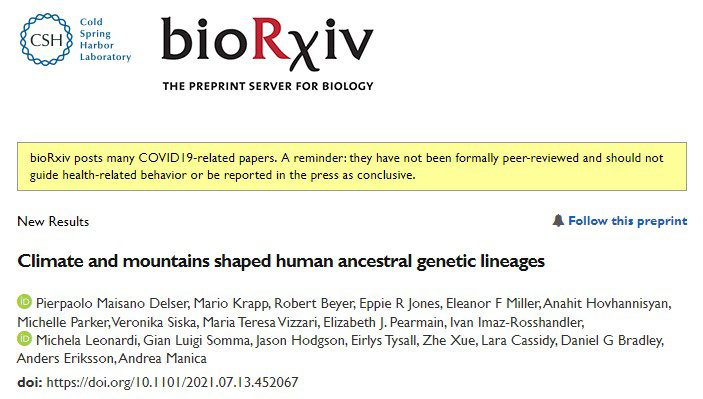So excited to have contributed to this amazing new preprint!

In this study, we quantified the role of climate and mountains in shaping modern and ancient human genetic diversity.
Genomics shows that contemporary human populations result from the mixing of ancestral groups that are genetically distinct (ancestral genetic lineages) with unknown origins. In theory, ancient DNA could help disentangling their origin, but not in this case because we don’t have enough samples of the right age.
For this reason, we used a different strategy. We explicitly simulated the genetic history of humans in their spread out of Africa testing different values for demographic parameters and physiological responses to the changing climate. By doing so we could see if we can reconstruct the observed genetic diversity (spoiler alert: yes) and which parameters and climate variables shaped it.

For example, we find that aridity is the key factor controlling the timing for the out of Africa and mountains can be huge genetic barriers but only in some areas (e.g. Caucasus and Himalayas, not the Urals).
Thanks to this study, not only we could reconstruct such an important part of our genetic history, but we could also quantify the differential role of climate and topography through space and time in our spread out of Africa.
Preprint
Pierpaolo Maisano Delser, Mario Krapp, Robert Beyer, Eppie R Jones, Eleanor F Miller, Anahit Hovhannisyan, Michelle Parker, Veronika Siska, Maria Teresa Vizzari, Elizabeth J. Pearmain, Ivan Imaz-Rosshandler, Michela Leonardi, Gian Luigi Somma, Jason Hodgson, Eirlys Tysall, Zhe Xue, Lara Cassidy, Daniel G Bradley, Anders Eriksson, Andrea Manica
Climate and mountains shaped human ancestral genetic lineages
bioRxiv 2021.07.13.452067; doi: https://doi.org/10.1101/2021.07.13.452067
Abstract
Extensive sequencing of modern and ancient human genomes has revealed that contemporary populations can be explained as the result of recent mixing of a few distinct ancestral genetic lineages. But the small number of aDNA samples that predate the Last Glacial Maximum means that the origins of these lineages are not well understood. Here, we circumvent the limited sampling by modelling explicitly the effect of climatic changes and terrain on population demography and migrations through time and space, and show that these factors are sufficient to explain the divergence among ancestral lineages. Our reconstructions show that the sharp separation between African and Eurasian lineages is a consequence of only a few limited periods of connectivity through the arid Arabian peninsula, which acted as the gate out of the African continent. The subsequent spread across Eurasia was then mostly shaped by mountain ranges, and to a lesser extent deserts, leading to the split of Europeans and Asians, and the further diversification of these two groups. A high tolerance to cold climates allowed the persistence at high latitudes even during the Last Glacial Maximum, maintaining a pocket in Beringia that led to the later, rapid colonisation of the Americas. The advent of food production was associated with an increase in movement, but mountains and climate have been shown to still play a major role even in this latter period, affecting the mixing of the ancestral lineages that we have shown to be shaped by those two factors in the first place.

